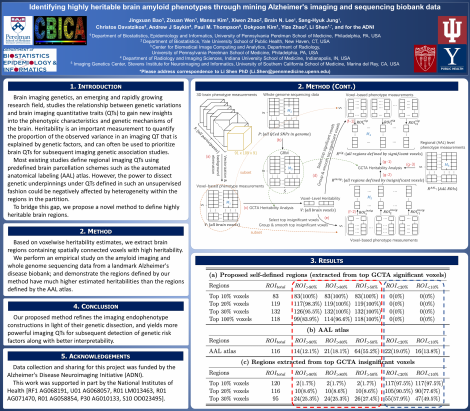Jingxuan Bao
Identifying Highly Heritable Brain Amyloid Phenotypes Through Mining Alzheimer’s Imaging and Sequencing Biobank Data

Presenter
Flash Talk Presenter
Jingxuan Bao is a Ph.D. student in Genomics and Computational Biology at Penn. He received his MA degree in Applied Mathematics and Computational Science from the University of Pennsylvania. His research interests include machine learning, applied mathematics, imaging genomics, and biomedical data science.
Abstract
Brain imaging genetics, an emerging and rapidly growing research field, studies the relationship between genetic variations and brain imaging quantitative traits (QTs) to gain new insights into the phenotypic characteristics and genetic mechanisms of the brain. Heritability is an important measurement to quantify the proportion of the observed variance in an imaging QT that is explained by genetic factors, and can often be used to prioritize brain QTs for subsequent imaging genetic association studies. Most existing studies define regional imaging QTs using predefined brain parcellation schemes such as the automated anatomical labeling (AAL) atlas. However, the power to dissect genetic underpinnings under QTL defined in such an unsupervised fashion could be negatively affected by heterogeneity within the regions in the partition. To bridge this gap, we propose a novel method to define highly heritable brain regions. Based on voxelwise heritability estimates, we extract brain regions containing spatially connected voxels with high heritability. We perform an empirical study on the amyloid imaging and whole-genome sequencing data from a land-mark Alzheimer's disease biobank; and demonstrate the regions defined by our method have much higher estimated heritabilities than the regions defined by the AAL atlas. Our proposed method refines the imaging endophenotype constructions in light of their genetic dissection, and yields more powerful imaging QTs for subsequent detection of genetic risk factors along with better interpretability.
Keywords
Heritability, Quantitative trait, Brain imaging genetics, Alzheimer’s DiseaseAbout Us
To understand health and disease today, we need new thinking and novel science —the kind we create when multiple disciplines work together from the ground up. That is why this department has put forward a bold vision in population-health science: a single academic home for biostatistics, epidemiology and informatics.
© 2023 Trustees of the University of Pennsylvania. All rights reserved.. | Disclaimer

